lamp Citroen C4 PICASSO 2016 2.G Workshop Manual
[x] Cancel search | Manufacturer: CITROEN, Model Year: 2016, Model line: C4 PICASSO, Model: Citroen C4 PICASSO 2016 2.GPages: 527, PDF Size: 13.72 MB
Page 123 of 527
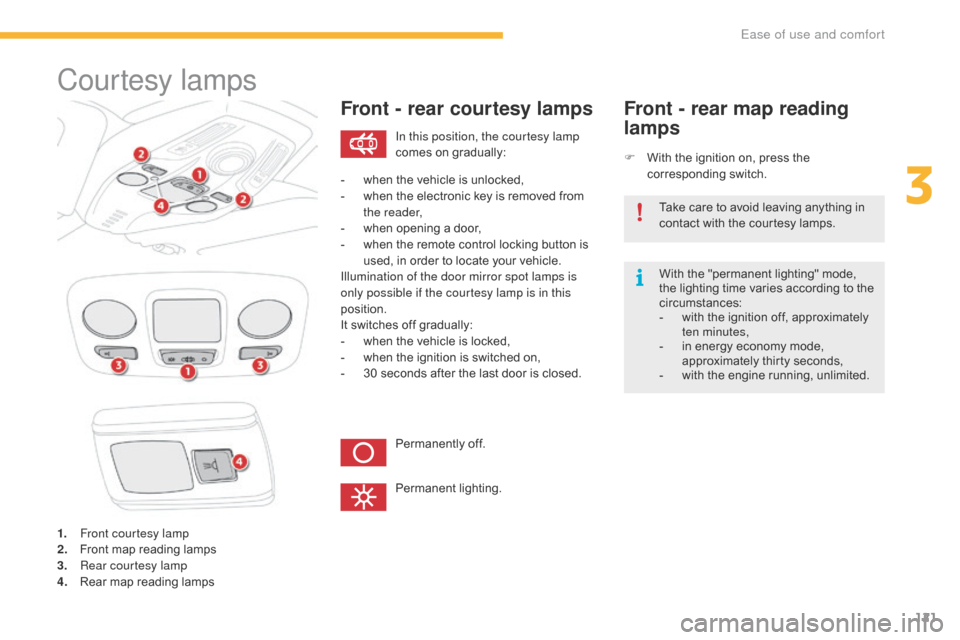
121
C4-Picasso-II_en_Chap03_ergonomie-confort_ed01-2016
Courtesy lamps
1. Front courtesy lamp
2. Front map reading lamps
3.
R
ear courtesy lamp
4.
R
ear map reading lamps
Front - rear courtesy lamps
F With the ignition on, press the c
orresponding s witch.
Front - rear map reading
lamps
With the "permanent lighting" mode, the lighting time varies according to the
c
ircumstances:
-
w
ith the ignition off, approximately
t
en minutes,
-
i
n energy economy mode,
a
pproximately thirty seconds,
-
w
ith the engine running, unlimited.
In this position, the courtesy lamp
comes
on
gradually:
Permanently
off.
Permanent
l
ighting.
-
w
hen
the
vehicle
is
unlocked,
-
w
hen
the
electronic
key
is
removed
from
t
he reader,
-
w
hen
opening
a
door,
-
w
hen
the
remote
control
locking
button
is
u
sed,
in
order
to
locate
your
vehicle.
Illumination of the door mirror spot lamps is
only possible if the courtesy lamp is in this
position.
It
switches
off
gradually:
-
w
hen
the
vehicle
is
locked,
-
w
hen
the
ignition
is
switched
on,
-
3
0
seconds
after
the
last
door
is
closed. Take
care to avoid leaving anything in
c
ontact with the courtesy lamps.
3
Ease of use and comfort
Page 124 of 527
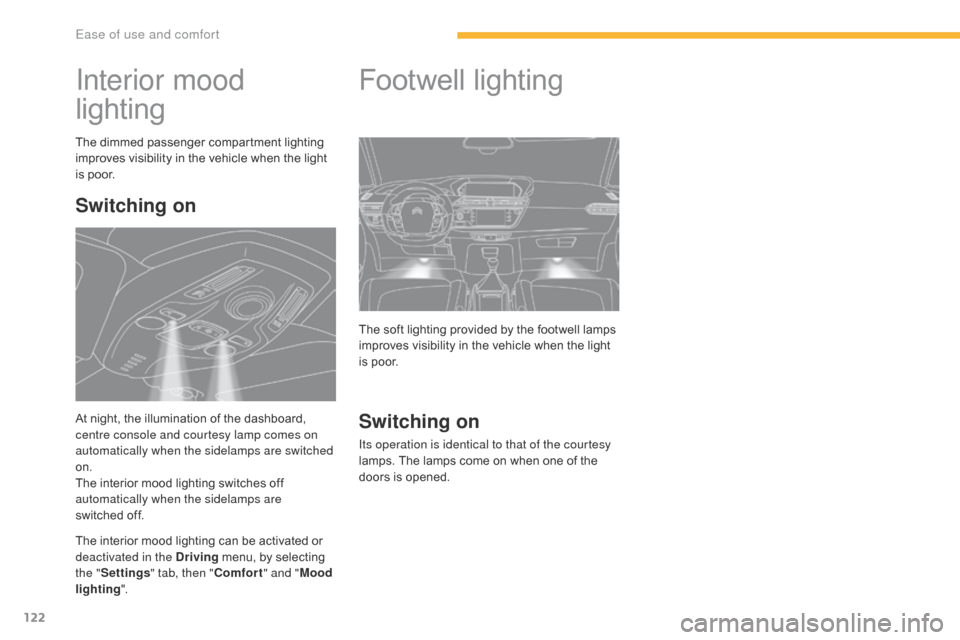
122
C4-Picasso-II_en_Chap03_ergonomie-confort_ed01-2016
Interior mood
lighting
The dimmed passenger compartment lighting improves visibility in the vehicle when the light
i
s poor.
The
interior mood lighting can be activated or
d
eactivated in the Driving
menu, by selecting
t
he " Settings " tab, then " Comfort" and "Mood
lighting ". The
soft lighting provided by the footwell lamps
i
mproves visibility in the vehicle when the light
i
s poor.
At
night, the illumination of the dashboard,
c
entre console and courtesy lamp comes on
automatically when the sidelamps are switched
on.
The
interior mood lighting switches off
a
utomatically when the sidelamps are
switched off.
Switching on
Footwell lighting
Switching on
Its operation is identical to that of the courtesy
lamps. The lamps come on when one of the
d
oors is opened.
Ease of use and comfort
Page 126 of 527
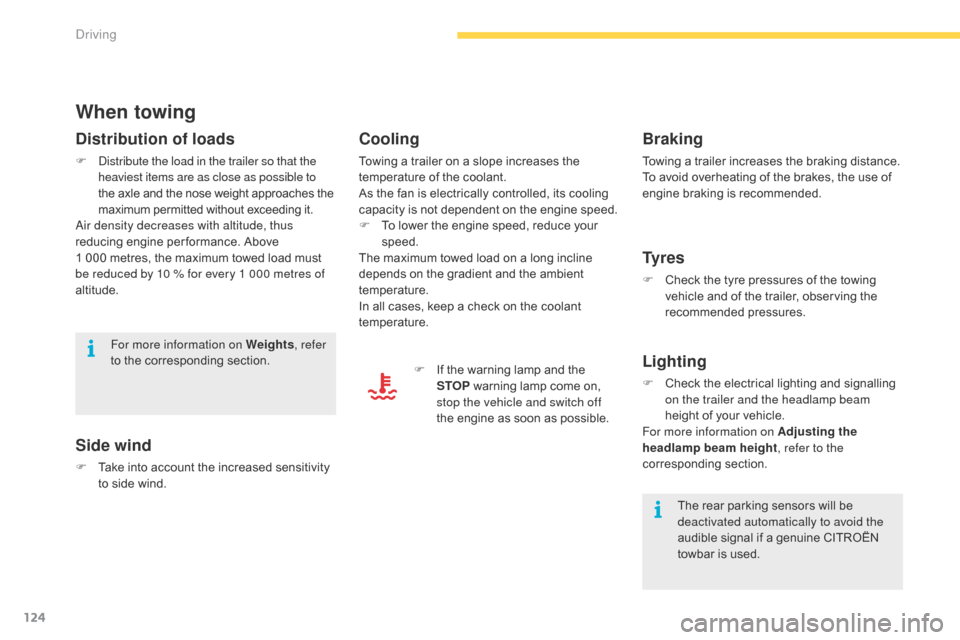
124
C4-Picasso-II_en_Chap04_conduite_ed01-2016
When towing
Distribution of loads
F Distribute the load in the trailer so that the heaviest items are as close as possible to
the
axle and the nose weight approaches the
m
aximum permitted without exceeding it.
Air density decreases with altitude, thus
reducing
engine per formance. Above
1 0
00 metres, the maximum towed load must
b
e reduced by 10 % for every 1 000 metres of
altitude.
Side wind
F Take into account the increased sensitivity t
o side wind.
For more information on Weights
, refer
to the corresponding section.
The rear parking sensors will be
d
eactivated automatically to avoid the
audible
signal if a genuine CITROËN
t
owbar is used.
Cooling
Towing a trailer on a slope increases the temperature of the coolant.
As
the fan is electrically controlled, its cooling
c
apacity is not dependent on the engine speed.
F
T
o lower the engine speed, reduce your
s
peed.
The
maximum towed load on a long incline
d
epends on the gradient and the ambient
t
emperature.
In
all cases, keep a check on the coolant
t
emperature. F
I
f the warning lamp and the
S
TOP
warning lamp come on,
s
top the vehicle and switch off
the
engine as soon as possible.
Braking
Towing a trailer increases the braking distance.
T o avoid overheating of the brakes, the use of
e
ngine braking is recommended.
Ty r e s
F Check the tyre pressures of the towing v
ehicle and of the trailer, observing the
re
commended
p
ressures.
Lighting
F Check the electrical lighting and signalling o
n the trailer and the headlamp beam
height
of your vehicle.
For more information on Adjusting the
headlamp beam height , refer to the
corresponding
s
ection.
Driving
Page 127 of 527

125
C4-Picasso-II_en_Chap04_conduite_ed01-2016
Starting-switching off the engine with the electronic key
F Place the gear selector lever at P or N
for vehicles with an automatic gearbox or
n
eutral with a manual gearbox.
F
I
nsert the electronic key in the reader.
F
P
ress the brake pedal for vehicles with an
a
utomatic gearbox, or fully declutch for
v
ehicles with a manual gearbox.
Starting the engine
For Diesel vehicles, in
temperatures below zero the
engine
will not start until the
p
reheater warning lamp has
g
one off.
If
one
of
the
starting
conditions
is
not
m
et,
a
reminder
message
appears
in
t
he
instrument
panel
screen.
In
some
c
ircumstances, it is necessary to
turn
the
steering
wheel
slightly
while
p
ressing
the
"START/STOP"
button
t
o
assist
unlocking
of
the
steering;
a
message
warns
you
when
this
is
ne
eded. F
B
riefly press the "
START/STOP"
button.
T
he
steering
column
unlocks
and
t
he
engine
starts
more
or
less
i
mmediately (see the advice for
Diesel
v
ersions). If
this
warning lamp comes on after
p
ressing "START/STOP", you should
h
old
the
brake or clutch pedal down
u
ntil
the
warning lamp goes off and
d
o
not
press the START/STOP button
ag
ain.
4
Driving
Page 129 of 527

127
C4-Picasso-II_en_Chap04_conduite_ed01-2016
Starting-switching off the engine with Keyless Entry and Starting
F Place the gear selector lever at P or N for
vehicles with an automatic gearbox, or
n
eutral with a manual gearbox.
F
W
ith the electronic key inside the vehicle,
p
ress the brake pedal for vehicles with an
a
utomatic gearbox, or fully declutch for
v
ehicles with a manual gearbox.
Diesel vehicles
In temperatures below zero the
engine will not start until the
p
reheater warning lamp has
g
one off.
Starting the engine
The presence of the "Keyless Entry and
Starting" electronic key in the recognition zone
i
s
e
ssential.
It
is not necessary to place the electronic key in
t
he back-up reader.
If
the electronic key is not detected,
a
message is displayed. Move the
e
lectronic key into the recognition zone
s
o that the engine can be started.
In the event of a problem, see "Key not
detected
/ Back-up starting".
F
B riefly press the "
S TA R T/
STOP "
button while maintaining
p
ressure on the pedal until the
engine
s
tarts.
If one of the starting conditions is not met, a reminder message appears in the i
nstrument panel screen.
In some circumstances, it is necessary
to
turn the steering wheel slightly while
p
ressing the "START/STOP " button
to
assist unlocking of the steering; a
m
essage warns you when this is needed.
As a safety measure, never leave the
vehicle while the engine is running.
The
steering
column
unlocks
and
the
engine
s
tarts
more
or
less
instantly.
See
the
advice
below
for
Diesel
versions. If
this warning lamp comes on after
p
ressing "START/STOP ", you should
hold
the brake or clutch pedal down
u
ntil the warning lamp goes off and do
n
ot press the " START/STOP " button
again
before the engine starts.
4
Driving
Page 133 of 527
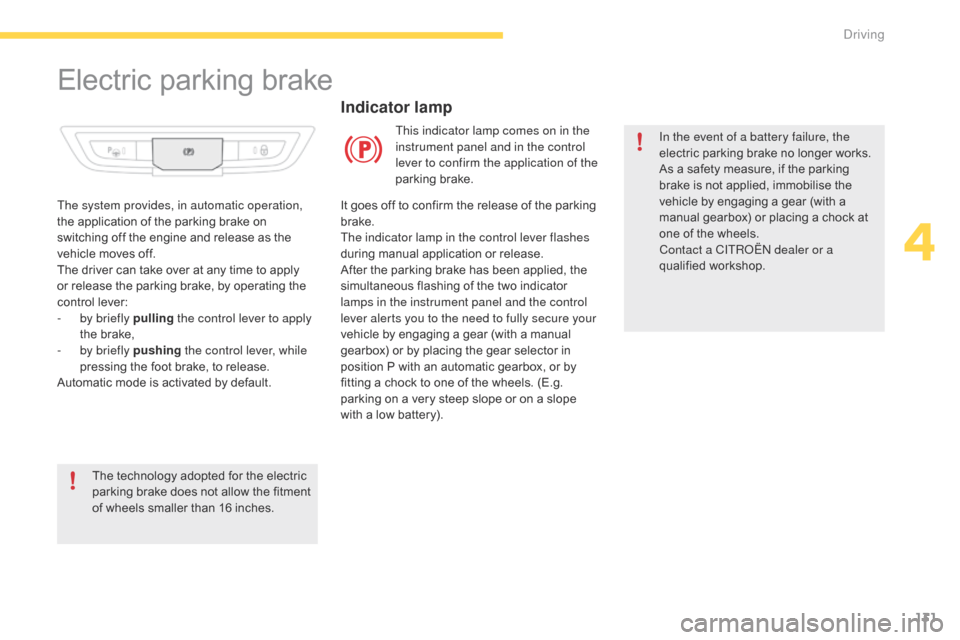
131
C4-Picasso-II_en_Chap04_conduite_ed01-2016
Electric parking brake
In the event of a battery failure, the
electric parking brake no longer works.
As
a safety measure, if the parking
b
rake is not applied, immobilise the
v
ehicle by engaging a gear (with a
m
anual gearbox) or placing a chock at
o
ne of the wheels.
Contact a CITROËN dealer or a
qualified
w
orkshop.
Indicator lamp
This indicator lamp comes on in the
instrument panel and in the control
lever to confirm the application of the
parking
b
rake.
The system provides, in automatic operation,
the
application
of
the
parking
brake
on
s
witching
off
the
engine
and
release
as
the
v
ehicle
moves
off.
The
driver
can
take
over
at
any
time
to
apply
o
r
release
the
parking
brake,
by
operating
the
c
ontrol
lever:
-
b
y briefly pulling the control lever to apply
the
brake,
-
b
y briefly pushing the control lever, while
pressing
the
foot
brake,
to
release.
Automatic
mode
is
activated
by
default.
The
technology
adopted
for
the
electric
p
arking
brake
does
not
allow
the
fitment
o
f
wheels
smaller
than
16
inches. It
goes
off
to confirm the release of the parking
b
rake.
The indicator lamp in the control lever flashes
during
manual application or release.
After
the
parking brake has been applied, the
s
imultaneous flashing of the two indicator
l
amps in the instrument panel and the control
lever alerts you to the need to fully secure your
vehicle
by
engaging a gear (with a manual
g
earbox)
or by placing the gear selector in
p
osition
P
with an automatic gearbox, or by
f
itting
a
chock to one of the wheels. (E.g.
p
arking
on a very steep slope or on a slope
w
ith
a
low
battery).
4
Driving
Page 134 of 527

132
C4-Picasso-II_en_Chap04_conduite_ed01-2016
Label on door panel
Before leaving the vehicle, check that the parking brake is applied: the
in
dicator lamps in the instrument panel
and
the control lever must be on fixed,
n
ot
f
lashing.
If
the parking brake is not applied, there
i
s an audible signal and a message is
d
isplayed on opening the driver's door.
Never leave a child alone inside the
vehicle
with the ignition on, as they
c
ould release the parking brake.When
towing, parking on a steep slope, o
r if your vehicle is heavily laden,
turn
the wheels towards the kerb and
e
ngage a gear (with a manual gearbox)
o
r place the gear selector at position P
with
an automatic gearbox.
For
towing, your vehicle is approved for
p
arking on slopes of up to 12%.
Manual operation
Application of the parking brake is confirmed by illumination of
the
brake indicator lamp and
t
he P indicator lamp in the control
lever, accompanied by the display of
the
m
essage
"
Parking
b
rake
a
pplied".
Manual release
With the ignition on or the engine running, to release the parking brake:
F
p
ress the brake pedal,
F
w
hile maintaining pressure on the brake
p
edal, briefly push the control lever.
The
complete release of the parking brake
i
s confirmed by the brake indicator lamp and
t
he P indicator lamp in the control lever going
o
ff,
a
ccompanied
b
y
t
he
d
isplay
o
f
t
he
m
essage
"
Parking brake released".
If you push the control lever without
pressing
the brake pedal, the parking
b
rake will not be released and a
m
essage is displayed.
Manual application
With the vehicle stationary: briefly pull the control lever.
Confirmation of the command is signalled by flashing of the indicator lamp in the control
l
eve r.
Driving
Page 135 of 527
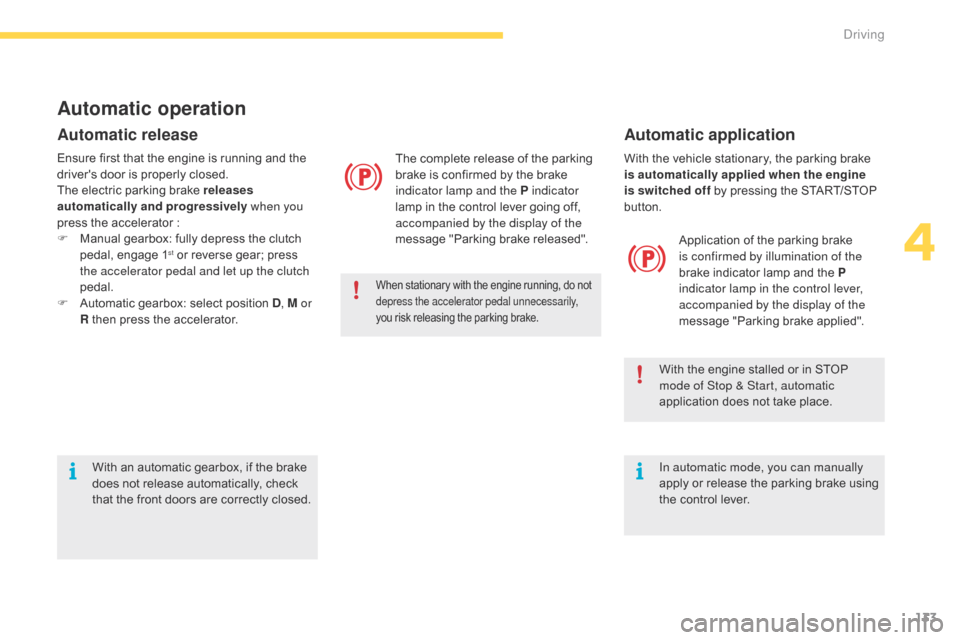
133
C4-Picasso-II_en_Chap04_conduite_ed01-2016
With the vehicle stationary, the parking brake is automatically applied when the engine
is switched off
by pressing the START/STOP
b
utton. Application
of the parking brake
i
s confirmed by illumination of the
brake
indicator lamp and the P
indicator lamp in the control lever,
accompanied by the display of the
message
"Parking brake applied".
With
the engine stalled or in STOP
m
ode of Stop & Start, automatic
application
does not take place.
In automatic mode, you can manually
apply
o
r
r
elease
t
he
p
arking
b
rake
u
sing
t
he control lever.
Automatic operation
Automatic release
The complete release of the parking brake is confirmed by the brake
i
ndicator lamp and the P indicator
lamp
in the control lever going off,
a
ccompanied by the display of the
message
"Parking brake released".
When stationary with the engine running, do not depress the accelerator pedal unnecessarily,
you
risk releasing the parking brake.
Ensure first that the engine is running and the driver's door is properly closed.
The
electric parking brake releases
automatically and progressively when you
press
the accelerator :
F
M
anual gearbox: fully depress the clutch
p
edal, engage 1
st or reverse gear; press t
he accelerator pedal and let up the clutch
pedal.
F
A
utomatic
gearbox: select position D, M or
R
then
press
the
accelerator.
Automatic application
With an automatic gearbox, if the brake d oes not release automatically, check
t
hat the front doors are correctly closed.
4
Driving
Page 136 of 527
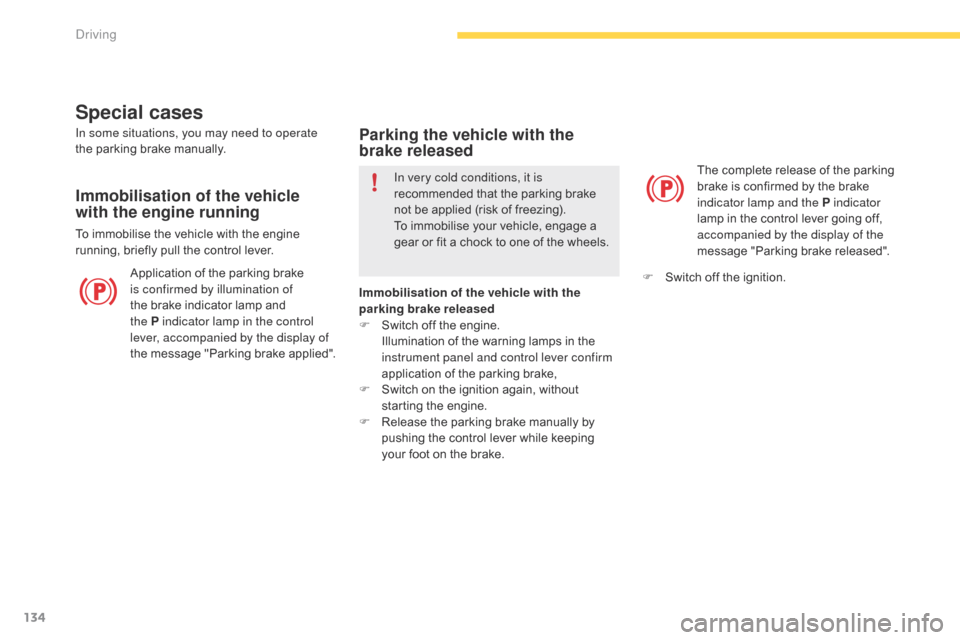
134
C4-Picasso-II_en_Chap04_conduite_ed01-2016
Special cases
Application of the parking brake is confirmed by illumination of
the
brake indicator lamp and
t
he P indicator lamp in the control
lever, accompanied by the display of
the
m
essage
"
Parking
b
rake
a
pplied". The
complete release of the parking
b
rake is confirmed by the brake
i
ndicator lamp and the P indicator
lamp in the control lever going off,
a
ccompanied by the display of the
message "Parking brake released".
In some situations, you may need to operate
the
parking brake manually.
Immobilisation of the vehicle
with the engine running
To immobilise the vehicle with the engine r
unning, briefly pull the control lever.
Parking the vehicle with the
brake released
In very cold conditions, it is
recommended that the parking brake
n
ot be applied (risk of freezing).
To
immobilise your vehicle, engage a
g
ear or fit a chock to one of the wheels.
Immobilisation of the vehicle with the
parking brake released
F
S
witch off the engine.
I
llumination of the warning lamps in the
i
nstrument panel and control lever confirm
application
of the parking brake,
F
S
witch on the ignition again, without
s
tarting the engine.
F
R
elease the parking brake manually by
p
ushing the control lever while keeping
y
our foot on the brake. F
S
witch off the ignition.
Driving
Page 137 of 527
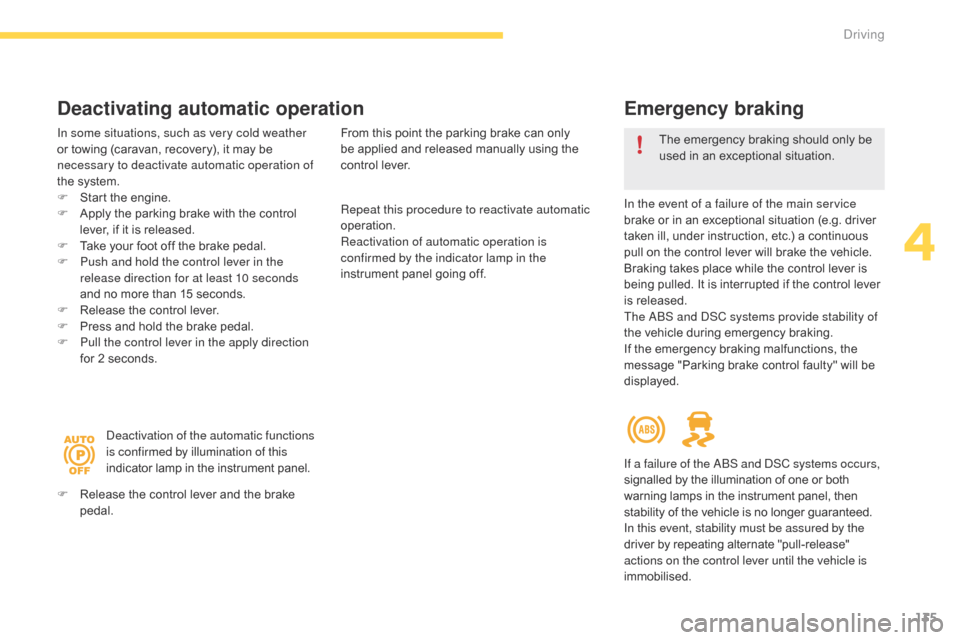
135
C4-Picasso-II_en_Chap04_conduite_ed01-2016
Emergency braking
In the event of a failure of the main service
brake or in an exceptional situation (e.g. driver
t
aken ill, under instruction, etc.) a continuous
p
ull on the control lever will brake the vehicle.
B
raking takes place while the control lever is
b
eing pulled. It is interrupted if the control lever
i
s
r
eleased.
The ABS and DSC systems provide stability of
the
vehicle during emergency braking.
If
the emergency braking malfunctions, the
m
essage "Parking brake control faulty" will be
d
isplayed.
If a failure of the ABS and DSC systems occurs,
signalled
by the illumination of one or both
w
arning lamps in the instrument panel, then
s
tability of the vehicle is no longer guaranteed.
In this event, stability must be assured by the
driver
by repeating alternate "pull-release"
a
ctions on the control lever until the vehicle is
immobilised. The
emergency braking should only be
u
sed in an exceptional situation.
Repeat this procedure to reactivate automatic
operation.
Reactivation of automatic operation is
confirmed by the indicator lamp in the
instrument
panel
going
off.
Deactivating automatic operation
In some situations, such as very cold weather
or towing (caravan, recovery), it may be
n
ecessary to deactivate automatic operation of
the
system.
F
S
tart the engine.
F
A
pply the parking brake with the control
l
ever, if it is released.
F
T
ake your foot off the brake pedal.
F
P
ush and hold the control lever in the
release direction for at least 10 seconds
and
no more than 15 seconds.
F
R
elease the control lever.
F
P
ress and hold the brake pedal.
F
P
ull the control lever in the apply direction
for
2 seconds.
Deactivation of the automatic functions
is confirmed by illumination of this
indicator
lamp in the instrument panel.
F
R
elease the control lever and the brake
ped
al. From
this point the parking brake can only b
e applied and released manually using the
c
ontrol lever.
4
Driving